Financial Performance Management Report: FNN6800, Dec 2020
VerifiedAdded on 2023/01/05
|12
|4061
|48
Report
AI Summary
This report, focusing on financial performance management, is divided into two main parts. The first part critically discusses the issues businesses face in managing environmental costs, detailing various accounting methods like prevention, appraisal, and failure costs, as well as cost-benefit analysis and different strategies for environmental cost identification such as input/output analysis and flow cost accounting. The second part explores decision-making within management accounting, emphasizing its role in financial planning and problem-solving. It examines various management accounting reports, including cost accounting, stock, and accounts receivable ageing reports, and analyzes how planning tools and techniques address financial issues like sales inconsistency and higher expenses. The report uses Morrison plc as a case study to illustrate these concepts, providing a comprehensive overview of financial performance management and its practical applications.
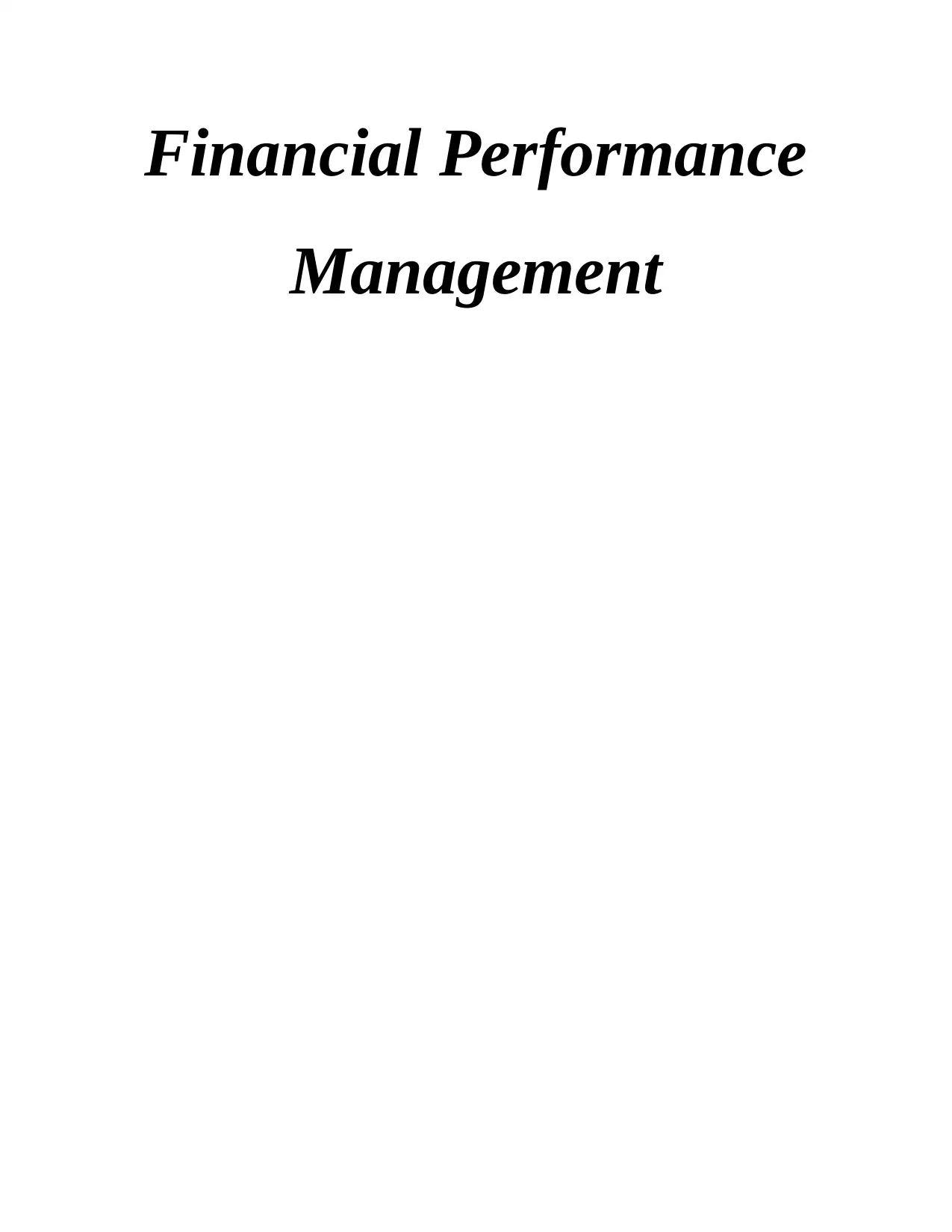
Financial Performance
Management
Management
Paraphrase This Document
Need a fresh take? Get an instant paraphrase of this document with our AI Paraphraser
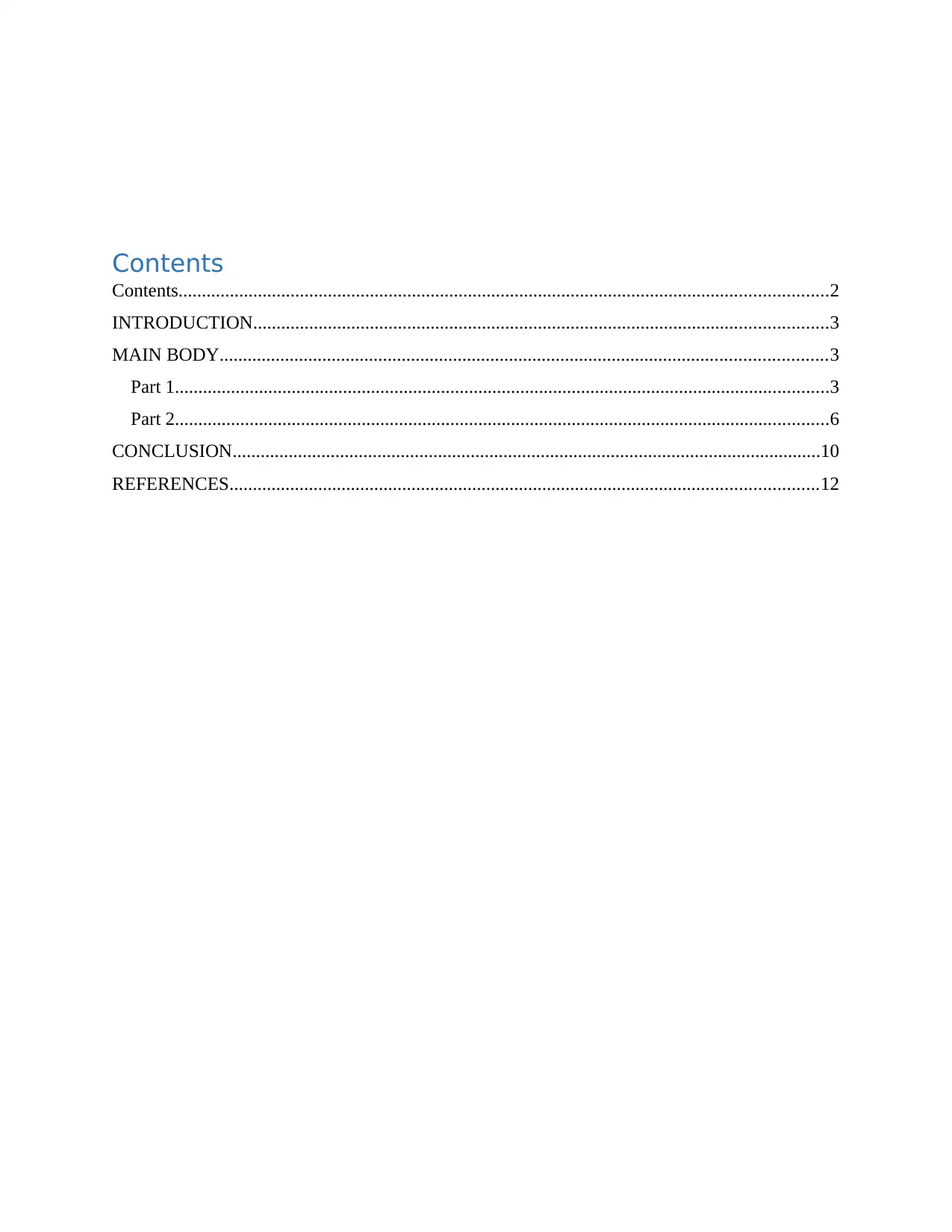
Contents
Contents...........................................................................................................................................2
INTRODUCTION...........................................................................................................................3
MAIN BODY..................................................................................................................................3
Part 1............................................................................................................................................3
Part 2............................................................................................................................................6
CONCLUSION..............................................................................................................................10
REFERENCES..............................................................................................................................12
Contents...........................................................................................................................................2
INTRODUCTION...........................................................................................................................3
MAIN BODY..................................................................................................................................3
Part 1............................................................................................................................................3
Part 2............................................................................................................................................6
CONCLUSION..............................................................................................................................10
REFERENCES..............................................................................................................................12
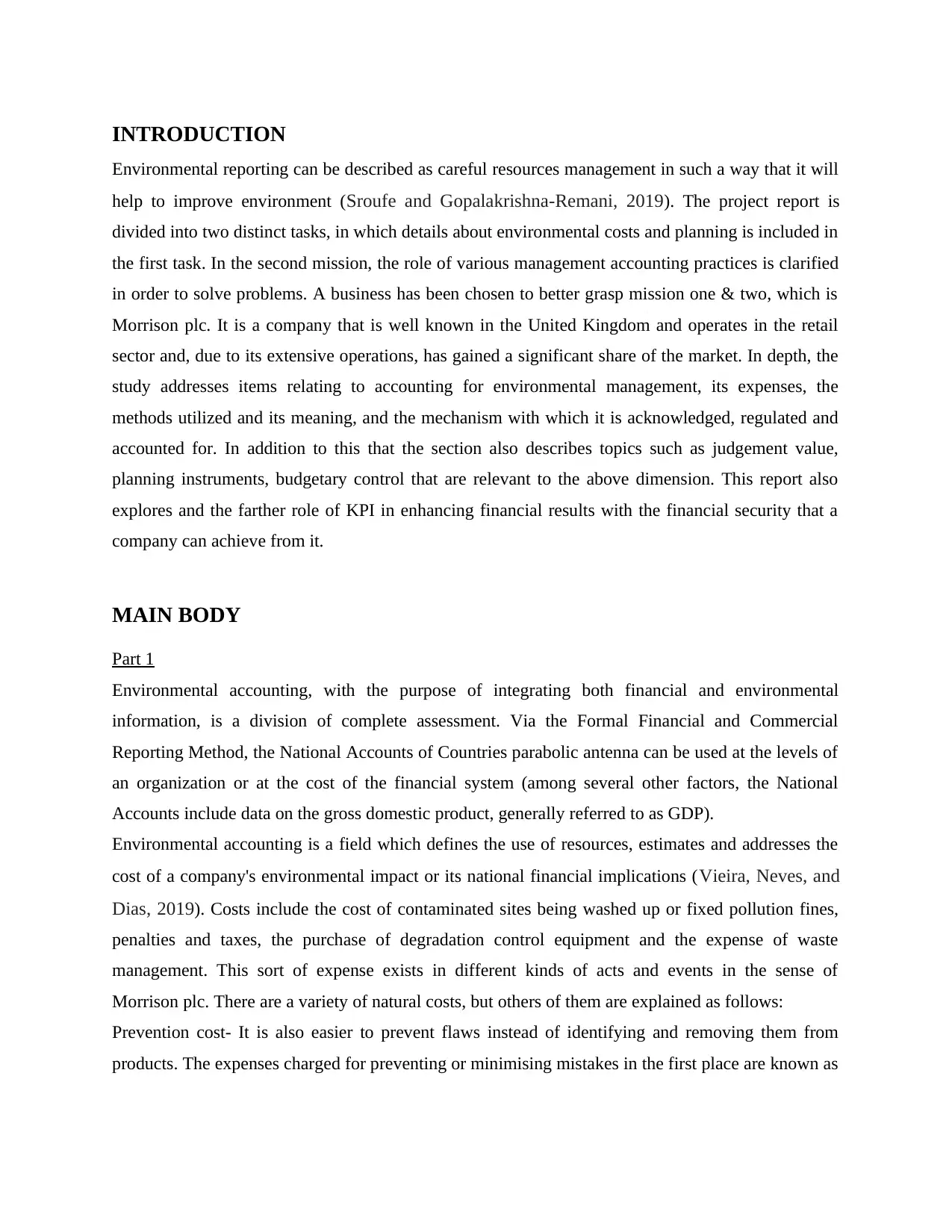
INTRODUCTION
Environmental reporting can be described as careful resources management in such a way that it will
help to improve environment (Sroufe and Gopalakrishna-Remani, 2019). The project report is
divided into two distinct tasks, in which details about environmental costs and planning is included in
the first task. In the second mission, the role of various management accounting practices is clarified
in order to solve problems. A business has been chosen to better grasp mission one & two, which is
Morrison plc. It is a company that is well known in the United Kingdom and operates in the retail
sector and, due to its extensive operations, has gained a significant share of the market. In depth, the
study addresses items relating to accounting for environmental management, its expenses, the
methods utilized and its meaning, and the mechanism with which it is acknowledged, regulated and
accounted for. In addition to this that the section also describes topics such as judgement value,
planning instruments, budgetary control that are relevant to the above dimension. This report also
explores and the farther role of KPI in enhancing financial results with the financial security that a
company can achieve from it.
MAIN BODY
Part 1
Environmental accounting, with the purpose of integrating both financial and environmental
information, is a division of complete assessment. Via the Formal Financial and Commercial
Reporting Method, the National Accounts of Countries parabolic antenna can be used at the levels of
an organization or at the cost of the financial system (among several other factors, the National
Accounts include data on the gross domestic product, generally referred to as GDP).
Environmental accounting is a field which defines the use of resources, estimates and addresses the
cost of a company's environmental impact or its national financial implications (Vieira, Neves, and
Dias, 2019). Costs include the cost of contaminated sites being washed up or fixed pollution fines,
penalties and taxes, the purchase of degradation control equipment and the expense of waste
management. This sort of expense exists in different kinds of acts and events in the sense of
Morrison plc. There are a variety of natural costs, but others of them are explained as follows:
Prevention cost- It is also easier to prevent flaws instead of identifying and removing them from
products. The expenses charged for preventing or minimising mistakes in the first place are known as
Environmental reporting can be described as careful resources management in such a way that it will
help to improve environment (Sroufe and Gopalakrishna-Remani, 2019). The project report is
divided into two distinct tasks, in which details about environmental costs and planning is included in
the first task. In the second mission, the role of various management accounting practices is clarified
in order to solve problems. A business has been chosen to better grasp mission one & two, which is
Morrison plc. It is a company that is well known in the United Kingdom and operates in the retail
sector and, due to its extensive operations, has gained a significant share of the market. In depth, the
study addresses items relating to accounting for environmental management, its expenses, the
methods utilized and its meaning, and the mechanism with which it is acknowledged, regulated and
accounted for. In addition to this that the section also describes topics such as judgement value,
planning instruments, budgetary control that are relevant to the above dimension. This report also
explores and the farther role of KPI in enhancing financial results with the financial security that a
company can achieve from it.
MAIN BODY
Part 1
Environmental accounting, with the purpose of integrating both financial and environmental
information, is a division of complete assessment. Via the Formal Financial and Commercial
Reporting Method, the National Accounts of Countries parabolic antenna can be used at the levels of
an organization or at the cost of the financial system (among several other factors, the National
Accounts include data on the gross domestic product, generally referred to as GDP).
Environmental accounting is a field which defines the use of resources, estimates and addresses the
cost of a company's environmental impact or its national financial implications (Vieira, Neves, and
Dias, 2019). Costs include the cost of contaminated sites being washed up or fixed pollution fines,
penalties and taxes, the purchase of degradation control equipment and the expense of waste
management. This sort of expense exists in different kinds of acts and events in the sense of
Morrison plc. There are a variety of natural costs, but others of them are explained as follows:
Prevention cost- It is also easier to prevent flaws instead of identifying and removing them from
products. The expenses charged for preventing or minimising mistakes in the first place are known as
⊘ This is a preview!⊘
Do you want full access?
Subscribe today to unlock all pages.

Trusted by 1+ million students worldwide

prevention costs. Any metrics of cost avoidance are the development of manufacturing processes,
staff planning, production creativity, computational process control, etc.
Appraisal cost- Appraisal costs (also recognized as inspection costs) are all those costs incurred in
order to locate damaged products before being shipped to customers. This division also includes all
the costs involved with the activity that is carried out to meet the required quality standards during
manufacturing cycles. The management of an investigator team includes the identification of
damaged objects. That can be very costly for some organisations.
External failure cost- External failure costs exist when buyers have been supplied with defective
items. External damage expenses include replacements, upgrades, lost profits due to low reputation,
compensation for damages arising from the use of damaged products, etc. Clients can be dissatisfied
with the distribution of damaged merchandise, destroying goodwill, and reducing sales and profits.
Morrison plc does not regulate all forms of costs, since these costs will arise at any moment ( Xie,
Huo and Zou, 2019).
Internal failure cost-Internal fault expense is the expense of eliminating defects from the items that
are accumulated before shipping them to customers. Internal failure costs are occasions of rolling,
discarded products, scrap, etc. This expense arises because of internal weakness in Morrison plc
which leads to a detrimental effect on their profitability.
Cost-benefit analysis: Cost-benefit framework is a strategy used by organisations to determine
choices. The business or analyst counts up the gains of a condition or decision and then subtracts
the risks of taking measures. In order to offer a dollar figure, certain observers or scholars also
create models for intangible items, such as the gains and expenses relative to residing in a certain
region. This is used in comparison with the above business to calculate the number of items that
need to be generated to meet no loss and no benefit line. It is better for firms to hedge from risks
by way of this analysis, and they are able to cover running expenses.
Identification of environmental costs: A company with multiple opportunities to boost the
bottom line is able to recognise and eliminate additional charges for environmental expenses.
Moreover, corporations perform environmental activities to comply with a plurality of local,
national, and federal regulations. The establishment of an environmental management policy and
the provision of sufficient, timely judgement knowledge contribute, through the application of
pollution prevention measures and best manufacturing practises, to the elimination of excessive
staff planning, production creativity, computational process control, etc.
Appraisal cost- Appraisal costs (also recognized as inspection costs) are all those costs incurred in
order to locate damaged products before being shipped to customers. This division also includes all
the costs involved with the activity that is carried out to meet the required quality standards during
manufacturing cycles. The management of an investigator team includes the identification of
damaged objects. That can be very costly for some organisations.
External failure cost- External failure costs exist when buyers have been supplied with defective
items. External damage expenses include replacements, upgrades, lost profits due to low reputation,
compensation for damages arising from the use of damaged products, etc. Clients can be dissatisfied
with the distribution of damaged merchandise, destroying goodwill, and reducing sales and profits.
Morrison plc does not regulate all forms of costs, since these costs will arise at any moment ( Xie,
Huo and Zou, 2019).
Internal failure cost-Internal fault expense is the expense of eliminating defects from the items that
are accumulated before shipping them to customers. Internal failure costs are occasions of rolling,
discarded products, scrap, etc. This expense arises because of internal weakness in Morrison plc
which leads to a detrimental effect on their profitability.
Cost-benefit analysis: Cost-benefit framework is a strategy used by organisations to determine
choices. The business or analyst counts up the gains of a condition or decision and then subtracts
the risks of taking measures. In order to offer a dollar figure, certain observers or scholars also
create models for intangible items, such as the gains and expenses relative to residing in a certain
region. This is used in comparison with the above business to calculate the number of items that
need to be generated to meet no loss and no benefit line. It is better for firms to hedge from risks
by way of this analysis, and they are able to cover running expenses.
Identification of environmental costs: A company with multiple opportunities to boost the
bottom line is able to recognise and eliminate additional charges for environmental expenses.
Moreover, corporations perform environmental activities to comply with a plurality of local,
national, and federal regulations. The establishment of an environmental management policy and
the provision of sufficient, timely judgement knowledge contribute, through the application of
pollution prevention measures and best manufacturing practises, to the elimination of excessive
Paraphrase This Document
Need a fresh take? Get an instant paraphrase of this document with our AI Paraphraser
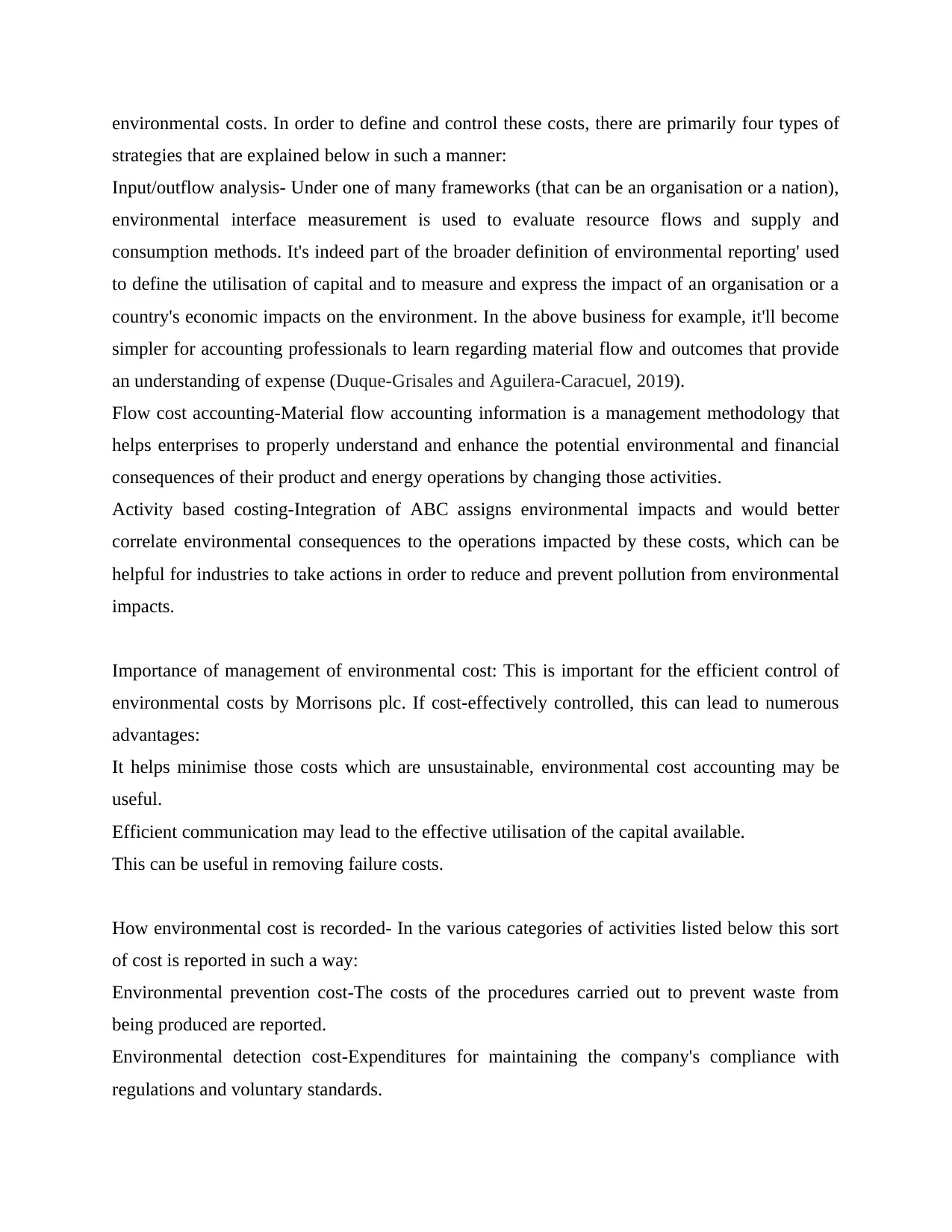
environmental costs. In order to define and control these costs, there are primarily four types of
strategies that are explained below in such a manner:
Input/outflow analysis- Under one of many frameworks (that can be an organisation or a nation),
environmental interface measurement is used to evaluate resource flows and supply and
consumption methods. It's indeed part of the broader definition of environmental reporting' used
to define the utilisation of capital and to measure and express the impact of an organisation or a
country's economic impacts on the environment. In the above business for example, it'll become
simpler for accounting professionals to learn regarding material flow and outcomes that provide
an understanding of expense (Duque-Grisales and Aguilera-Caracuel, 2019).
Flow cost accounting-Material flow accounting information is a management methodology that
helps enterprises to properly understand and enhance the potential environmental and financial
consequences of their product and energy operations by changing those activities.
Activity based costing-Integration of ABC assigns environmental impacts and would better
correlate environmental consequences to the operations impacted by these costs, which can be
helpful for industries to take actions in order to reduce and prevent pollution from environmental
impacts.
Importance of management of environmental cost: This is important for the efficient control of
environmental costs by Morrisons plc. If cost-effectively controlled, this can lead to numerous
advantages:
It helps minimise those costs which are unsustainable, environmental cost accounting may be
useful.
Efficient communication may lead to the effective utilisation of the capital available.
This can be useful in removing failure costs.
How environmental cost is recorded- In the various categories of activities listed below this sort
of cost is reported in such a way:
Environmental prevention cost-The costs of the procedures carried out to prevent waste from
being produced are reported.
Environmental detection cost-Expenditures for maintaining the company's compliance with
regulations and voluntary standards.
strategies that are explained below in such a manner:
Input/outflow analysis- Under one of many frameworks (that can be an organisation or a nation),
environmental interface measurement is used to evaluate resource flows and supply and
consumption methods. It's indeed part of the broader definition of environmental reporting' used
to define the utilisation of capital and to measure and express the impact of an organisation or a
country's economic impacts on the environment. In the above business for example, it'll become
simpler for accounting professionals to learn regarding material flow and outcomes that provide
an understanding of expense (Duque-Grisales and Aguilera-Caracuel, 2019).
Flow cost accounting-Material flow accounting information is a management methodology that
helps enterprises to properly understand and enhance the potential environmental and financial
consequences of their product and energy operations by changing those activities.
Activity based costing-Integration of ABC assigns environmental impacts and would better
correlate environmental consequences to the operations impacted by these costs, which can be
helpful for industries to take actions in order to reduce and prevent pollution from environmental
impacts.
Importance of management of environmental cost: This is important for the efficient control of
environmental costs by Morrisons plc. If cost-effectively controlled, this can lead to numerous
advantages:
It helps minimise those costs which are unsustainable, environmental cost accounting may be
useful.
Efficient communication may lead to the effective utilisation of the capital available.
This can be useful in removing failure costs.
How environmental cost is recorded- In the various categories of activities listed below this sort
of cost is reported in such a way:
Environmental prevention cost-The costs of the procedures carried out to prevent waste from
being produced are reported.
Environmental detection cost-Expenditures for maintaining the company's compliance with
regulations and voluntary standards.
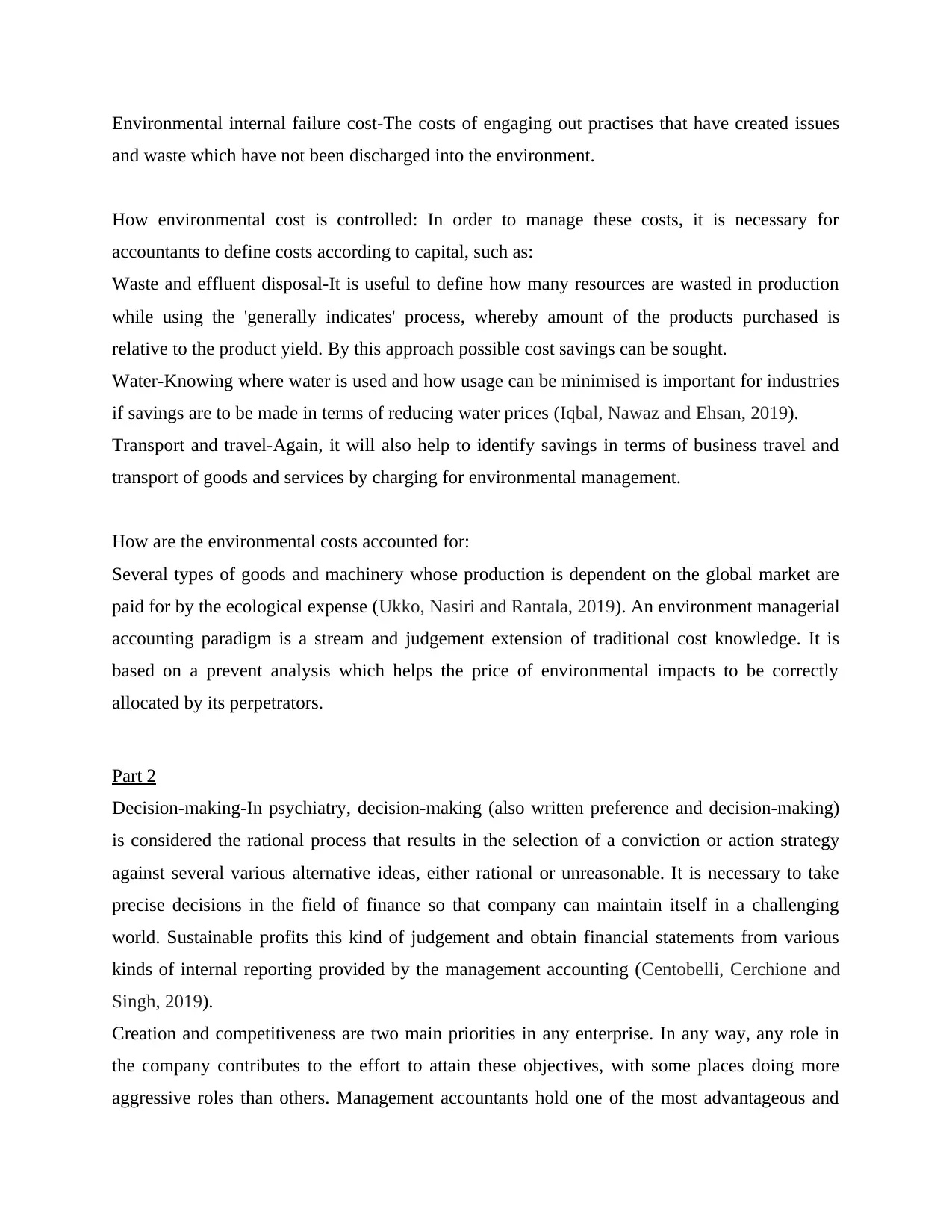
Environmental internal failure cost-The costs of engaging out practises that have created issues
and waste which have not been discharged into the environment.
How environmental cost is controlled: In order to manage these costs, it is necessary for
accountants to define costs according to capital, such as:
Waste and effluent disposal-It is useful to define how many resources are wasted in production
while using the 'generally indicates' process, whereby amount of the products purchased is
relative to the product yield. By this approach possible cost savings can be sought.
Water-Knowing where water is used and how usage can be minimised is important for industries
if savings are to be made in terms of reducing water prices (Iqbal, Nawaz and Ehsan, 2019).
Transport and travel-Again, it will also help to identify savings in terms of business travel and
transport of goods and services by charging for environmental management.
How are the environmental costs accounted for:
Several types of goods and machinery whose production is dependent on the global market are
paid for by the ecological expense (Ukko, Nasiri and Rantala, 2019). An environment managerial
accounting paradigm is a stream and judgement extension of traditional cost knowledge. It is
based on a prevent analysis which helps the price of environmental impacts to be correctly
allocated by its perpetrators.
Part 2
Decision-making-In psychiatry, decision-making (also written preference and decision-making)
is considered the rational process that results in the selection of a conviction or action strategy
against several various alternative ideas, either rational or unreasonable. It is necessary to take
precise decisions in the field of finance so that company can maintain itself in a challenging
world. Sustainable profits this kind of judgement and obtain financial statements from various
kinds of internal reporting provided by the management accounting (Centobelli, Cerchione and
Singh, 2019).
Creation and competitiveness are two main priorities in any enterprise. In any way, any role in
the company contributes to the effort to attain these objectives, with some places doing more
aggressive roles than others. Management accountants hold one of the most advantageous and
and waste which have not been discharged into the environment.
How environmental cost is controlled: In order to manage these costs, it is necessary for
accountants to define costs according to capital, such as:
Waste and effluent disposal-It is useful to define how many resources are wasted in production
while using the 'generally indicates' process, whereby amount of the products purchased is
relative to the product yield. By this approach possible cost savings can be sought.
Water-Knowing where water is used and how usage can be minimised is important for industries
if savings are to be made in terms of reducing water prices (Iqbal, Nawaz and Ehsan, 2019).
Transport and travel-Again, it will also help to identify savings in terms of business travel and
transport of goods and services by charging for environmental management.
How are the environmental costs accounted for:
Several types of goods and machinery whose production is dependent on the global market are
paid for by the ecological expense (Ukko, Nasiri and Rantala, 2019). An environment managerial
accounting paradigm is a stream and judgement extension of traditional cost knowledge. It is
based on a prevent analysis which helps the price of environmental impacts to be correctly
allocated by its perpetrators.
Part 2
Decision-making-In psychiatry, decision-making (also written preference and decision-making)
is considered the rational process that results in the selection of a conviction or action strategy
against several various alternative ideas, either rational or unreasonable. It is necessary to take
precise decisions in the field of finance so that company can maintain itself in a challenging
world. Sustainable profits this kind of judgement and obtain financial statements from various
kinds of internal reporting provided by the management accounting (Centobelli, Cerchione and
Singh, 2019).
Creation and competitiveness are two main priorities in any enterprise. In any way, any role in
the company contributes to the effort to attain these objectives, with some places doing more
aggressive roles than others. Management accountants hold one of the most advantageous and
⊘ This is a preview!⊘
Do you want full access?
Subscribe today to unlock all pages.

Trusted by 1+ million students worldwide
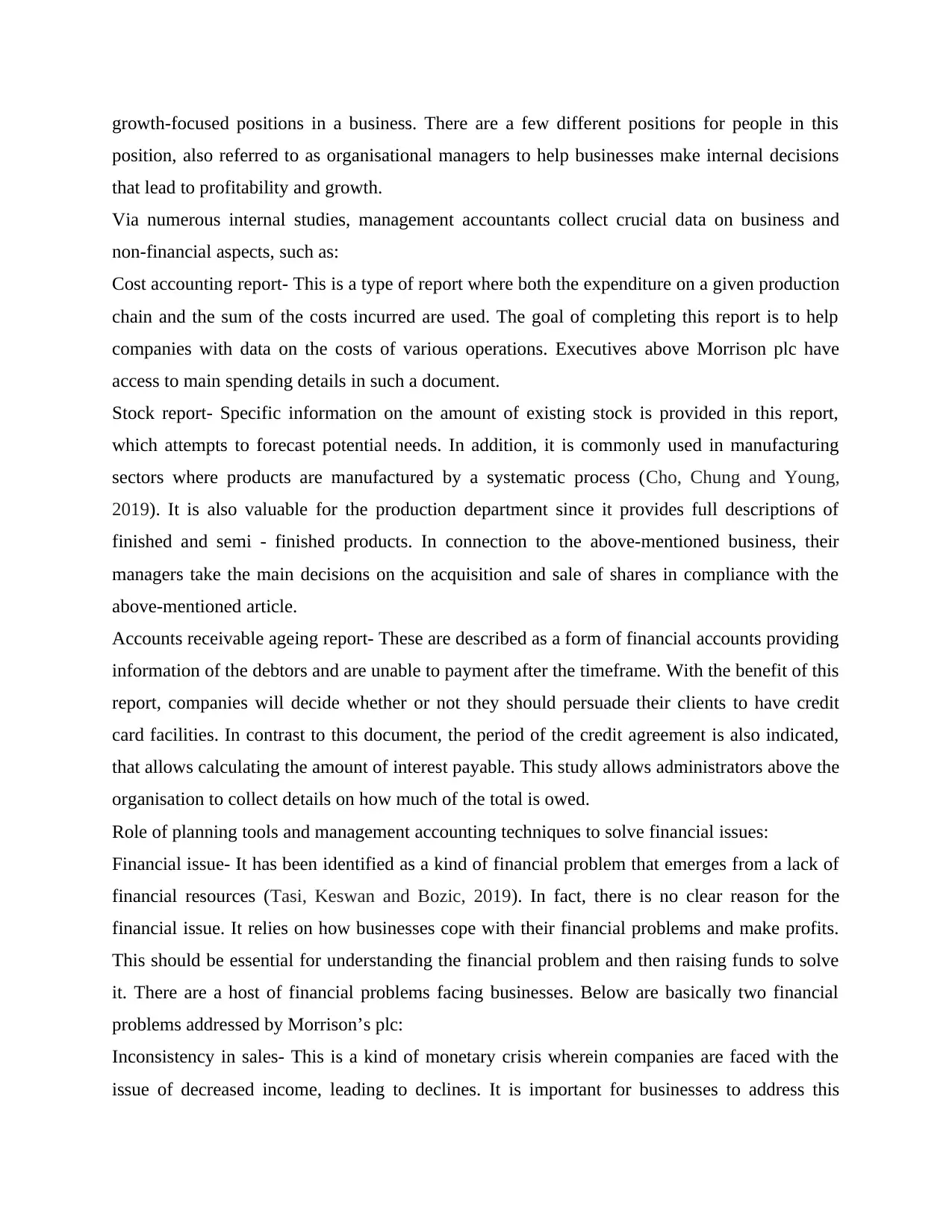
growth-focused positions in a business. There are a few different positions for people in this
position, also referred to as organisational managers to help businesses make internal decisions
that lead to profitability and growth.
Via numerous internal studies, management accountants collect crucial data on business and
non-financial aspects, such as:
Cost accounting report- This is a type of report where both the expenditure on a given production
chain and the sum of the costs incurred are used. The goal of completing this report is to help
companies with data on the costs of various operations. Executives above Morrison plc have
access to main spending details in such a document.
Stock report- Specific information on the amount of existing stock is provided in this report,
which attempts to forecast potential needs. In addition, it is commonly used in manufacturing
sectors where products are manufactured by a systematic process (Cho, Chung and Young,
2019). It is also valuable for the production department since it provides full descriptions of
finished and semi - finished products. In connection to the above-mentioned business, their
managers take the main decisions on the acquisition and sale of shares in compliance with the
above-mentioned article.
Accounts receivable ageing report- These are described as a form of financial accounts providing
information of the debtors and are unable to payment after the timeframe. With the benefit of this
report, companies will decide whether or not they should persuade their clients to have credit
card facilities. In contrast to this document, the period of the credit agreement is also indicated,
that allows calculating the amount of interest payable. This study allows administrators above the
organisation to collect details on how much of the total is owed.
Role of planning tools and management accounting techniques to solve financial issues:
Financial issue- It has been identified as a kind of financial problem that emerges from a lack of
financial resources (Tasi, Keswan and Bozic, 2019). In fact, there is no clear reason for the
financial issue. It relies on how businesses cope with their financial problems and make profits.
This should be essential for understanding the financial problem and then raising funds to solve
it. There are a host of financial problems facing businesses. Below are basically two financial
problems addressed by Morrison’s plc:
Inconsistency in sales- This is a kind of monetary crisis wherein companies are faced with the
issue of decreased income, leading to declines. It is important for businesses to address this
position, also referred to as organisational managers to help businesses make internal decisions
that lead to profitability and growth.
Via numerous internal studies, management accountants collect crucial data on business and
non-financial aspects, such as:
Cost accounting report- This is a type of report where both the expenditure on a given production
chain and the sum of the costs incurred are used. The goal of completing this report is to help
companies with data on the costs of various operations. Executives above Morrison plc have
access to main spending details in such a document.
Stock report- Specific information on the amount of existing stock is provided in this report,
which attempts to forecast potential needs. In addition, it is commonly used in manufacturing
sectors where products are manufactured by a systematic process (Cho, Chung and Young,
2019). It is also valuable for the production department since it provides full descriptions of
finished and semi - finished products. In connection to the above-mentioned business, their
managers take the main decisions on the acquisition and sale of shares in compliance with the
above-mentioned article.
Accounts receivable ageing report- These are described as a form of financial accounts providing
information of the debtors and are unable to payment after the timeframe. With the benefit of this
report, companies will decide whether or not they should persuade their clients to have credit
card facilities. In contrast to this document, the period of the credit agreement is also indicated,
that allows calculating the amount of interest payable. This study allows administrators above the
organisation to collect details on how much of the total is owed.
Role of planning tools and management accounting techniques to solve financial issues:
Financial issue- It has been identified as a kind of financial problem that emerges from a lack of
financial resources (Tasi, Keswan and Bozic, 2019). In fact, there is no clear reason for the
financial issue. It relies on how businesses cope with their financial problems and make profits.
This should be essential for understanding the financial problem and then raising funds to solve
it. There are a host of financial problems facing businesses. Below are basically two financial
problems addressed by Morrison’s plc:
Inconsistency in sales- This is a kind of monetary crisis wherein companies are faced with the
issue of decreased income, leading to declines. It is important for businesses to address this
Paraphrase This Document
Need a fresh take? Get an instant paraphrase of this document with our AI Paraphraser
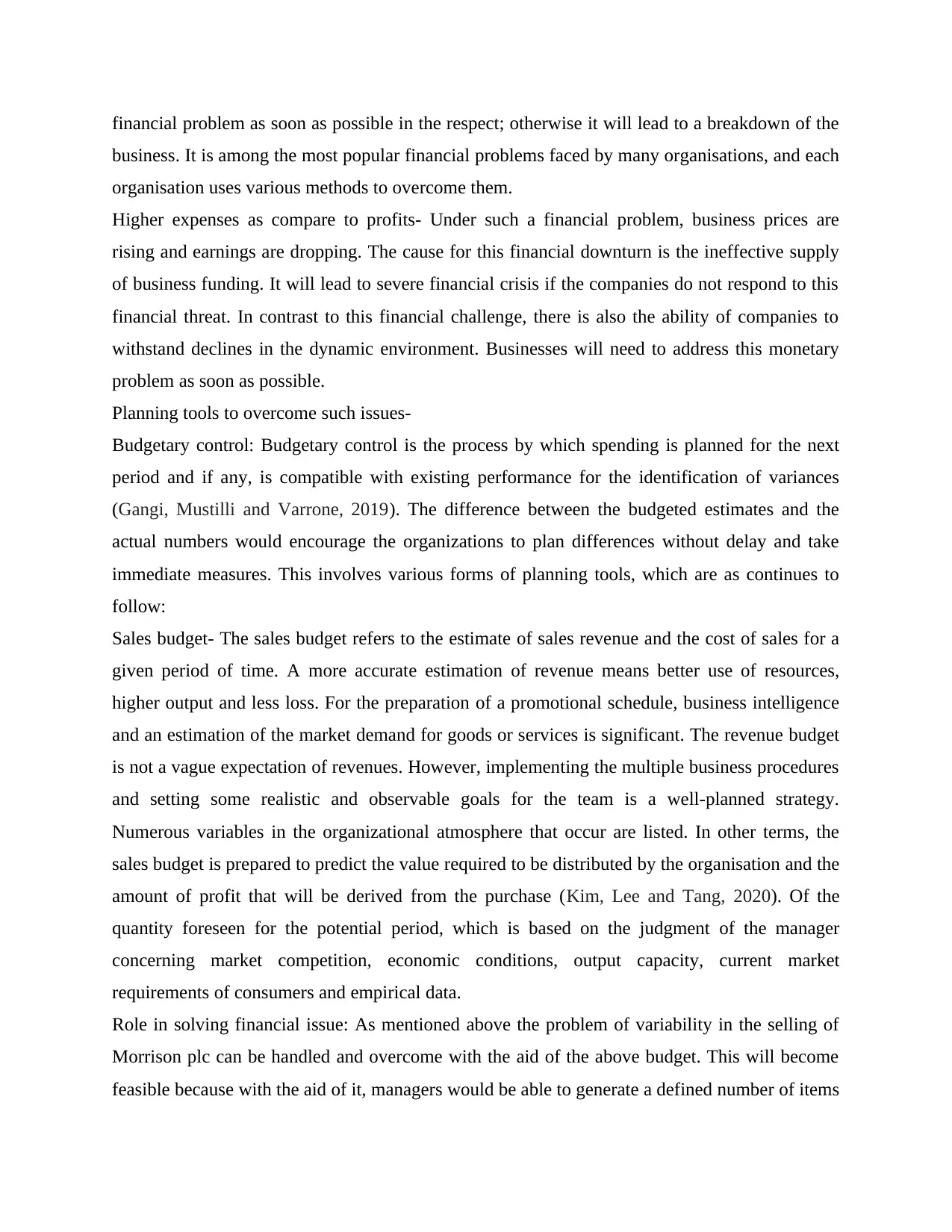
financial problem as soon as possible in the respect; otherwise it will lead to a breakdown of the
business. It is among the most popular financial problems faced by many organisations, and each
organisation uses various methods to overcome them.
Higher expenses as compare to profits- Under such a financial problem, business prices are
rising and earnings are dropping. The cause for this financial downturn is the ineffective supply
of business funding. It will lead to severe financial crisis if the companies do not respond to this
financial threat. In contrast to this financial challenge, there is also the ability of companies to
withstand declines in the dynamic environment. Businesses will need to address this monetary
problem as soon as possible.
Planning tools to overcome such issues-
Budgetary control: Budgetary control is the process by which spending is planned for the next
period and if any, is compatible with existing performance for the identification of variances
(Gangi, Mustilli and Varrone, 2019). The difference between the budgeted estimates and the
actual numbers would encourage the organizations to plan differences without delay and take
immediate measures. This involves various forms of planning tools, which are as continues to
follow:
Sales budget- The sales budget refers to the estimate of sales revenue and the cost of sales for a
given period of time. A more accurate estimation of revenue means better use of resources,
higher output and less loss. For the preparation of a promotional schedule, business intelligence
and an estimation of the market demand for goods or services is significant. The revenue budget
is not a vague expectation of revenues. However, implementing the multiple business procedures
and setting some realistic and observable goals for the team is a well-planned strategy.
Numerous variables in the organizational atmosphere that occur are listed. In other terms, the
sales budget is prepared to predict the value required to be distributed by the organisation and the
amount of profit that will be derived from the purchase (Kim, Lee and Tang, 2020). Of the
quantity foreseen for the potential period, which is based on the judgment of the manager
concerning market competition, economic conditions, output capacity, current market
requirements of consumers and empirical data.
Role in solving financial issue: As mentioned above the problem of variability in the selling of
Morrison plc can be handled and overcome with the aid of the above budget. This will become
feasible because with the aid of it, managers would be able to generate a defined number of items
business. It is among the most popular financial problems faced by many organisations, and each
organisation uses various methods to overcome them.
Higher expenses as compare to profits- Under such a financial problem, business prices are
rising and earnings are dropping. The cause for this financial downturn is the ineffective supply
of business funding. It will lead to severe financial crisis if the companies do not respond to this
financial threat. In contrast to this financial challenge, there is also the ability of companies to
withstand declines in the dynamic environment. Businesses will need to address this monetary
problem as soon as possible.
Planning tools to overcome such issues-
Budgetary control: Budgetary control is the process by which spending is planned for the next
period and if any, is compatible with existing performance for the identification of variances
(Gangi, Mustilli and Varrone, 2019). The difference between the budgeted estimates and the
actual numbers would encourage the organizations to plan differences without delay and take
immediate measures. This involves various forms of planning tools, which are as continues to
follow:
Sales budget- The sales budget refers to the estimate of sales revenue and the cost of sales for a
given period of time. A more accurate estimation of revenue means better use of resources,
higher output and less loss. For the preparation of a promotional schedule, business intelligence
and an estimation of the market demand for goods or services is significant. The revenue budget
is not a vague expectation of revenues. However, implementing the multiple business procedures
and setting some realistic and observable goals for the team is a well-planned strategy.
Numerous variables in the organizational atmosphere that occur are listed. In other terms, the
sales budget is prepared to predict the value required to be distributed by the organisation and the
amount of profit that will be derived from the purchase (Kim, Lee and Tang, 2020). Of the
quantity foreseen for the potential period, which is based on the judgment of the manager
concerning market competition, economic conditions, output capacity, current market
requirements of consumers and empirical data.
Role in solving financial issue: As mentioned above the problem of variability in the selling of
Morrison plc can be handled and overcome with the aid of the above budget. This will become
feasible because with the aid of it, managers would be able to generate a defined number of items
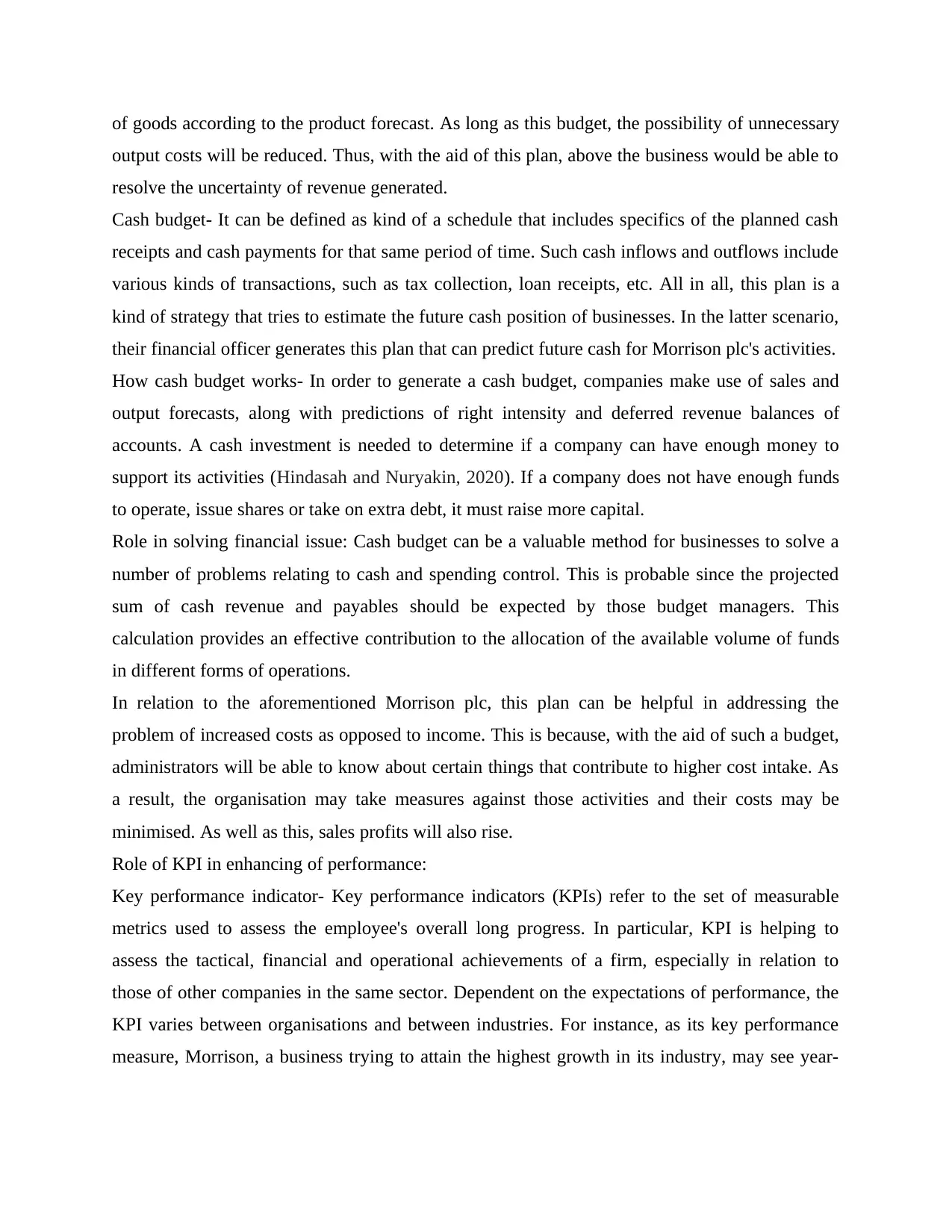
of goods according to the product forecast. As long as this budget, the possibility of unnecessary
output costs will be reduced. Thus, with the aid of this plan, above the business would be able to
resolve the uncertainty of revenue generated.
Cash budget- It can be defined as kind of a schedule that includes specifics of the planned cash
receipts and cash payments for that same period of time. Such cash inflows and outflows include
various kinds of transactions, such as tax collection, loan receipts, etc. All in all, this plan is a
kind of strategy that tries to estimate the future cash position of businesses. In the latter scenario,
their financial officer generates this plan that can predict future cash for Morrison plc's activities.
How cash budget works- In order to generate a cash budget, companies make use of sales and
output forecasts, along with predictions of right intensity and deferred revenue balances of
accounts. A cash investment is needed to determine if a company can have enough money to
support its activities (Hindasah and Nuryakin, 2020). If a company does not have enough funds
to operate, issue shares or take on extra debt, it must raise more capital.
Role in solving financial issue: Cash budget can be a valuable method for businesses to solve a
number of problems relating to cash and spending control. This is probable since the projected
sum of cash revenue and payables should be expected by those budget managers. This
calculation provides an effective contribution to the allocation of the available volume of funds
in different forms of operations.
In relation to the aforementioned Morrison plc, this plan can be helpful in addressing the
problem of increased costs as opposed to income. This is because, with the aid of such a budget,
administrators will be able to know about certain things that contribute to higher cost intake. As
a result, the organisation may take measures against those activities and their costs may be
minimised. As well as this, sales profits will also rise.
Role of KPI in enhancing of performance:
Key performance indicator- Key performance indicators (KPIs) refer to the set of measurable
metrics used to assess the employee's overall long progress. In particular, KPI is helping to
assess the tactical, financial and operational achievements of a firm, especially in relation to
those of other companies in the same sector. Dependent on the expectations of performance, the
KPI varies between organisations and between industries. For instance, as its key performance
measure, Morrison, a business trying to attain the highest growth in its industry, may see year-
output costs will be reduced. Thus, with the aid of this plan, above the business would be able to
resolve the uncertainty of revenue generated.
Cash budget- It can be defined as kind of a schedule that includes specifics of the planned cash
receipts and cash payments for that same period of time. Such cash inflows and outflows include
various kinds of transactions, such as tax collection, loan receipts, etc. All in all, this plan is a
kind of strategy that tries to estimate the future cash position of businesses. In the latter scenario,
their financial officer generates this plan that can predict future cash for Morrison plc's activities.
How cash budget works- In order to generate a cash budget, companies make use of sales and
output forecasts, along with predictions of right intensity and deferred revenue balances of
accounts. A cash investment is needed to determine if a company can have enough money to
support its activities (Hindasah and Nuryakin, 2020). If a company does not have enough funds
to operate, issue shares or take on extra debt, it must raise more capital.
Role in solving financial issue: Cash budget can be a valuable method for businesses to solve a
number of problems relating to cash and spending control. This is probable since the projected
sum of cash revenue and payables should be expected by those budget managers. This
calculation provides an effective contribution to the allocation of the available volume of funds
in different forms of operations.
In relation to the aforementioned Morrison plc, this plan can be helpful in addressing the
problem of increased costs as opposed to income. This is because, with the aid of such a budget,
administrators will be able to know about certain things that contribute to higher cost intake. As
a result, the organisation may take measures against those activities and their costs may be
minimised. As well as this, sales profits will also rise.
Role of KPI in enhancing of performance:
Key performance indicator- Key performance indicators (KPIs) refer to the set of measurable
metrics used to assess the employee's overall long progress. In particular, KPI is helping to
assess the tactical, financial and operational achievements of a firm, especially in relation to
those of other companies in the same sector. Dependent on the expectations of performance, the
KPI varies between organisations and between industries. For instance, as its key performance
measure, Morrison, a business trying to attain the highest growth in its industry, may see year-
⊘ This is a preview!⊘
Do you want full access?
Subscribe today to unlock all pages.

Trusted by 1+ million students worldwide
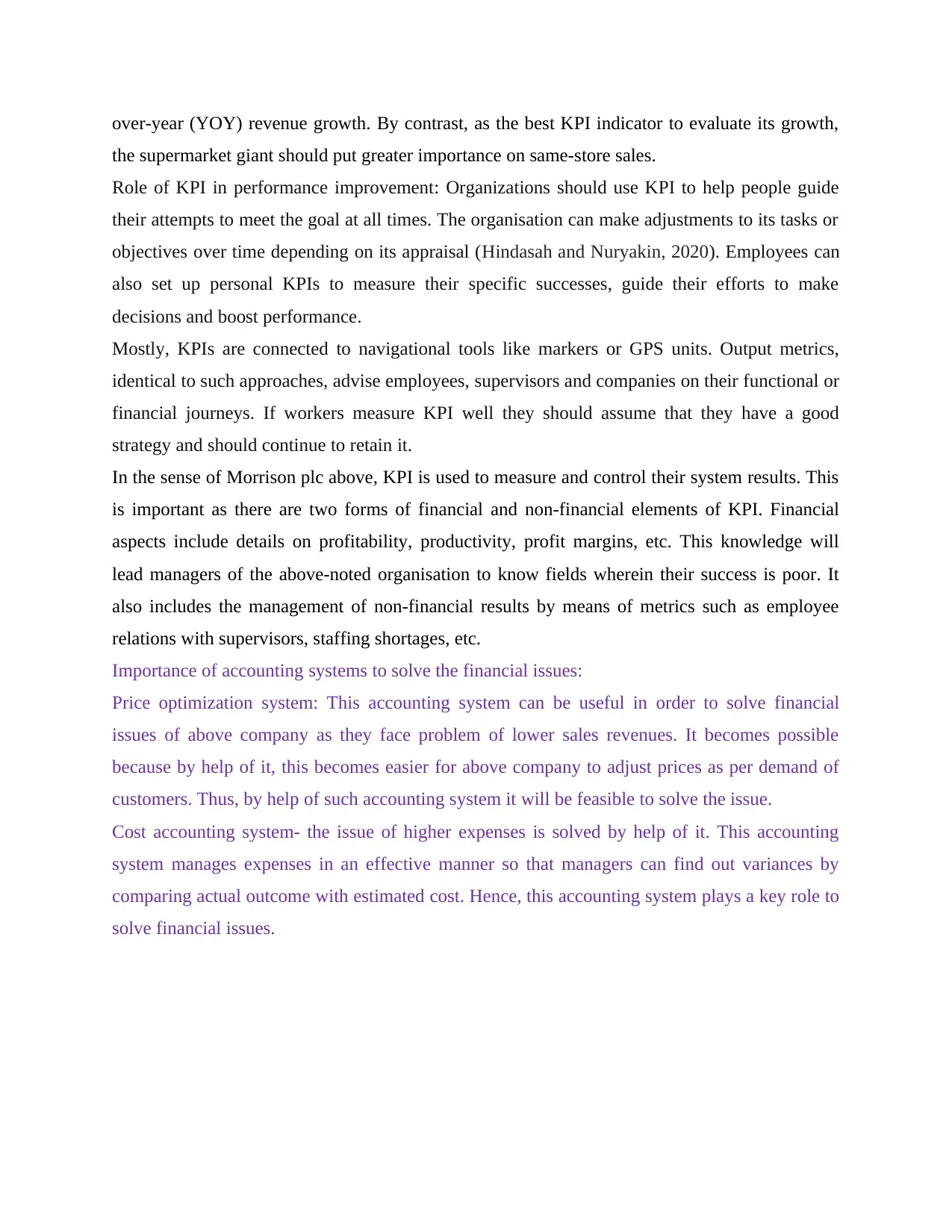
over-year (YOY) revenue growth. By contrast, as the best KPI indicator to evaluate its growth,
the supermarket giant should put greater importance on same-store sales.
Role of KPI in performance improvement: Organizations should use KPI to help people guide
their attempts to meet the goal at all times. The organisation can make adjustments to its tasks or
objectives over time depending on its appraisal (Hindasah and Nuryakin, 2020). Employees can
also set up personal KPIs to measure their specific successes, guide their efforts to make
decisions and boost performance.
Mostly, KPIs are connected to navigational tools like markers or GPS units. Output metrics,
identical to such approaches, advise employees, supervisors and companies on their functional or
financial journeys. If workers measure KPI well they should assume that they have a good
strategy and should continue to retain it.
In the sense of Morrison plc above, KPI is used to measure and control their system results. This
is important as there are two forms of financial and non-financial elements of KPI. Financial
aspects include details on profitability, productivity, profit margins, etc. This knowledge will
lead managers of the above-noted organisation to know fields wherein their success is poor. It
also includes the management of non-financial results by means of metrics such as employee
relations with supervisors, staffing shortages, etc.
Importance of accounting systems to solve the financial issues:
Price optimization system: This accounting system can be useful in order to solve financial
issues of above company as they face problem of lower sales revenues. It becomes possible
because by help of it, this becomes easier for above company to adjust prices as per demand of
customers. Thus, by help of such accounting system it will be feasible to solve the issue.
Cost accounting system- the issue of higher expenses is solved by help of it. This accounting
system manages expenses in an effective manner so that managers can find out variances by
comparing actual outcome with estimated cost. Hence, this accounting system plays a key role to
solve financial issues.
the supermarket giant should put greater importance on same-store sales.
Role of KPI in performance improvement: Organizations should use KPI to help people guide
their attempts to meet the goal at all times. The organisation can make adjustments to its tasks or
objectives over time depending on its appraisal (Hindasah and Nuryakin, 2020). Employees can
also set up personal KPIs to measure their specific successes, guide their efforts to make
decisions and boost performance.
Mostly, KPIs are connected to navigational tools like markers or GPS units. Output metrics,
identical to such approaches, advise employees, supervisors and companies on their functional or
financial journeys. If workers measure KPI well they should assume that they have a good
strategy and should continue to retain it.
In the sense of Morrison plc above, KPI is used to measure and control their system results. This
is important as there are two forms of financial and non-financial elements of KPI. Financial
aspects include details on profitability, productivity, profit margins, etc. This knowledge will
lead managers of the above-noted organisation to know fields wherein their success is poor. It
also includes the management of non-financial results by means of metrics such as employee
relations with supervisors, staffing shortages, etc.
Importance of accounting systems to solve the financial issues:
Price optimization system: This accounting system can be useful in order to solve financial
issues of above company as they face problem of lower sales revenues. It becomes possible
because by help of it, this becomes easier for above company to adjust prices as per demand of
customers. Thus, by help of such accounting system it will be feasible to solve the issue.
Cost accounting system- the issue of higher expenses is solved by help of it. This accounting
system manages expenses in an effective manner so that managers can find out variances by
comparing actual outcome with estimated cost. Hence, this accounting system plays a key role to
solve financial issues.
Paraphrase This Document
Need a fresh take? Get an instant paraphrase of this document with our AI Paraphraser
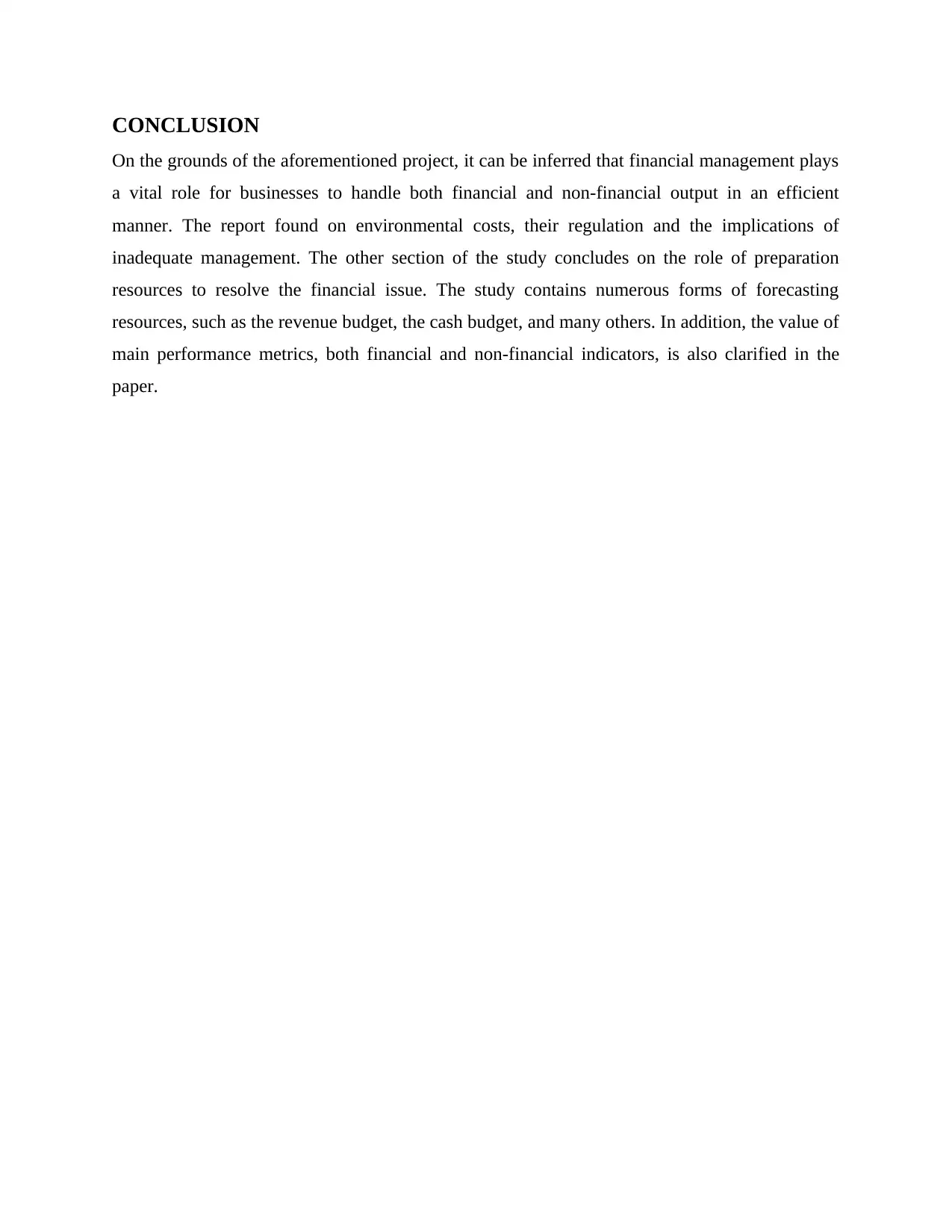
CONCLUSION
On the grounds of the aforementioned project, it can be inferred that financial management plays
a vital role for businesses to handle both financial and non-financial output in an efficient
manner. The report found on environmental costs, their regulation and the implications of
inadequate management. The other section of the study concludes on the role of preparation
resources to resolve the financial issue. The study contains numerous forms of forecasting
resources, such as the revenue budget, the cash budget, and many others. In addition, the value of
main performance metrics, both financial and non-financial indicators, is also clarified in the
paper.
On the grounds of the aforementioned project, it can be inferred that financial management plays
a vital role for businesses to handle both financial and non-financial output in an efficient
manner. The report found on environmental costs, their regulation and the implications of
inadequate management. The other section of the study concludes on the role of preparation
resources to resolve the financial issue. The study contains numerous forms of forecasting
resources, such as the revenue budget, the cash budget, and many others. In addition, the value of
main performance metrics, both financial and non-financial indicators, is also clarified in the
paper.
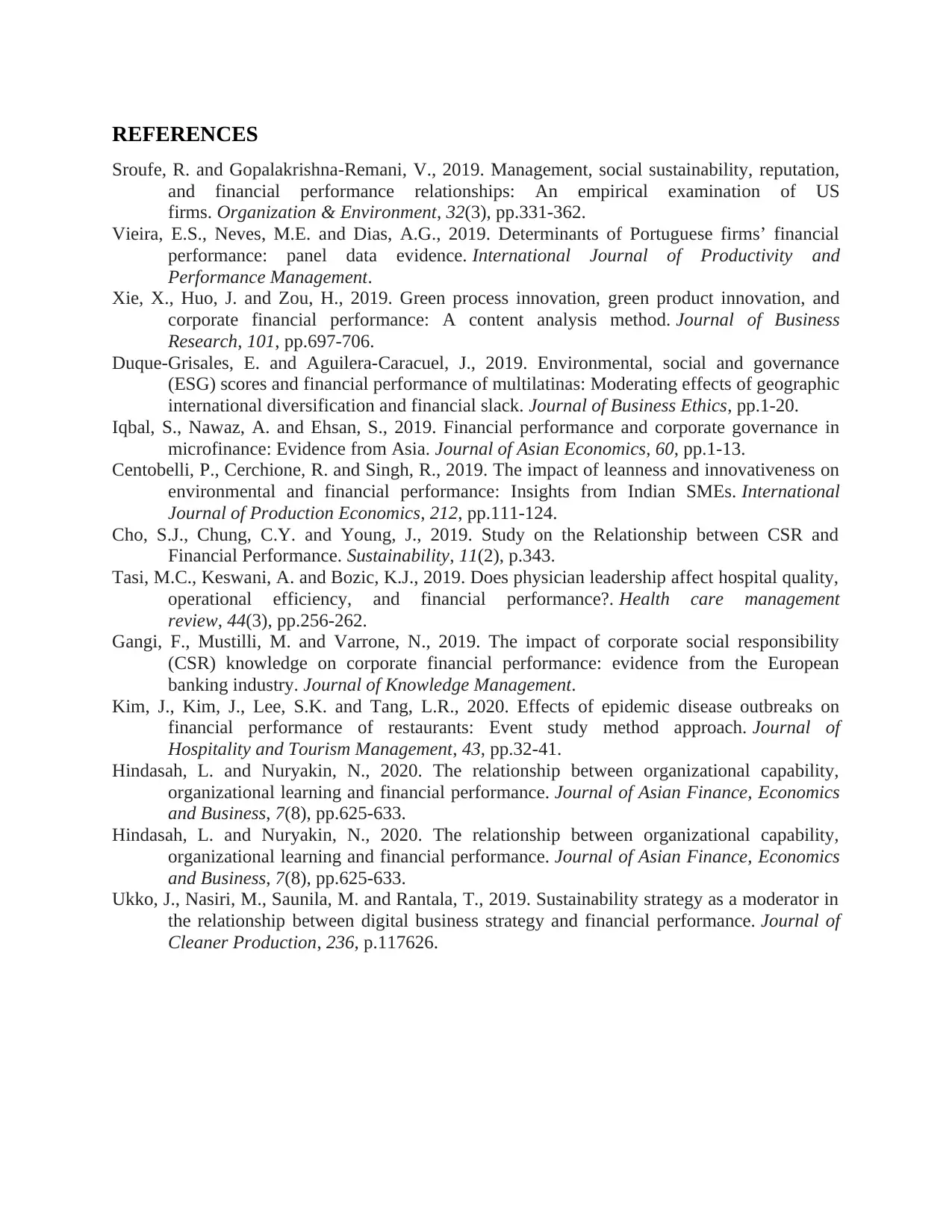
REFERENCES
Sroufe, R. and Gopalakrishna-Remani, V., 2019. Management, social sustainability, reputation,
and financial performance relationships: An empirical examination of US
firms. Organization & Environment, 32(3), pp.331-362.
Vieira, E.S., Neves, M.E. and Dias, A.G., 2019. Determinants of Portuguese firms’ financial
performance: panel data evidence. International Journal of Productivity and
Performance Management.
Xie, X., Huo, J. and Zou, H., 2019. Green process innovation, green product innovation, and
corporate financial performance: A content analysis method. Journal of Business
Research, 101, pp.697-706.
Duque-Grisales, E. and Aguilera-Caracuel, J., 2019. Environmental, social and governance
(ESG) scores and financial performance of multilatinas: Moderating effects of geographic
international diversification and financial slack. Journal of Business Ethics, pp.1-20.
Iqbal, S., Nawaz, A. and Ehsan, S., 2019. Financial performance and corporate governance in
microfinance: Evidence from Asia. Journal of Asian Economics, 60, pp.1-13.
Centobelli, P., Cerchione, R. and Singh, R., 2019. The impact of leanness and innovativeness on
environmental and financial performance: Insights from Indian SMEs. International
Journal of Production Economics, 212, pp.111-124.
Cho, S.J., Chung, C.Y. and Young, J., 2019. Study on the Relationship between CSR and
Financial Performance. Sustainability, 11(2), p.343.
Tasi, M.C., Keswani, A. and Bozic, K.J., 2019. Does physician leadership affect hospital quality,
operational efficiency, and financial performance?. Health care management
review, 44(3), pp.256-262.
Gangi, F., Mustilli, M. and Varrone, N., 2019. The impact of corporate social responsibility
(CSR) knowledge on corporate financial performance: evidence from the European
banking industry. Journal of Knowledge Management.
Kim, J., Kim, J., Lee, S.K. and Tang, L.R., 2020. Effects of epidemic disease outbreaks on
financial performance of restaurants: Event study method approach. Journal of
Hospitality and Tourism Management, 43, pp.32-41.
Hindasah, L. and Nuryakin, N., 2020. The relationship between organizational capability,
organizational learning and financial performance. Journal of Asian Finance, Economics
and Business, 7(8), pp.625-633.
Hindasah, L. and Nuryakin, N., 2020. The relationship between organizational capability,
organizational learning and financial performance. Journal of Asian Finance, Economics
and Business, 7(8), pp.625-633.
Ukko, J., Nasiri, M., Saunila, M. and Rantala, T., 2019. Sustainability strategy as a moderator in
the relationship between digital business strategy and financial performance. Journal of
Cleaner Production, 236, p.117626.
Sroufe, R. and Gopalakrishna-Remani, V., 2019. Management, social sustainability, reputation,
and financial performance relationships: An empirical examination of US
firms. Organization & Environment, 32(3), pp.331-362.
Vieira, E.S., Neves, M.E. and Dias, A.G., 2019. Determinants of Portuguese firms’ financial
performance: panel data evidence. International Journal of Productivity and
Performance Management.
Xie, X., Huo, J. and Zou, H., 2019. Green process innovation, green product innovation, and
corporate financial performance: A content analysis method. Journal of Business
Research, 101, pp.697-706.
Duque-Grisales, E. and Aguilera-Caracuel, J., 2019. Environmental, social and governance
(ESG) scores and financial performance of multilatinas: Moderating effects of geographic
international diversification and financial slack. Journal of Business Ethics, pp.1-20.
Iqbal, S., Nawaz, A. and Ehsan, S., 2019. Financial performance and corporate governance in
microfinance: Evidence from Asia. Journal of Asian Economics, 60, pp.1-13.
Centobelli, P., Cerchione, R. and Singh, R., 2019. The impact of leanness and innovativeness on
environmental and financial performance: Insights from Indian SMEs. International
Journal of Production Economics, 212, pp.111-124.
Cho, S.J., Chung, C.Y. and Young, J., 2019. Study on the Relationship between CSR and
Financial Performance. Sustainability, 11(2), p.343.
Tasi, M.C., Keswani, A. and Bozic, K.J., 2019. Does physician leadership affect hospital quality,
operational efficiency, and financial performance?. Health care management
review, 44(3), pp.256-262.
Gangi, F., Mustilli, M. and Varrone, N., 2019. The impact of corporate social responsibility
(CSR) knowledge on corporate financial performance: evidence from the European
banking industry. Journal of Knowledge Management.
Kim, J., Kim, J., Lee, S.K. and Tang, L.R., 2020. Effects of epidemic disease outbreaks on
financial performance of restaurants: Event study method approach. Journal of
Hospitality and Tourism Management, 43, pp.32-41.
Hindasah, L. and Nuryakin, N., 2020. The relationship between organizational capability,
organizational learning and financial performance. Journal of Asian Finance, Economics
and Business, 7(8), pp.625-633.
Hindasah, L. and Nuryakin, N., 2020. The relationship between organizational capability,
organizational learning and financial performance. Journal of Asian Finance, Economics
and Business, 7(8), pp.625-633.
Ukko, J., Nasiri, M., Saunila, M. and Rantala, T., 2019. Sustainability strategy as a moderator in
the relationship between digital business strategy and financial performance. Journal of
Cleaner Production, 236, p.117626.
⊘ This is a preview!⊘
Do you want full access?
Subscribe today to unlock all pages.

Trusted by 1+ million students worldwide
1 out of 12
Related Documents
Your All-in-One AI-Powered Toolkit for Academic Success.
+13062052269
info@desklib.com
Available 24*7 on WhatsApp / Email
![[object Object]](/_next/static/media/star-bottom.7253800d.svg)
Unlock your academic potential
Copyright © 2020–2025 A2Z Services. All Rights Reserved. Developed and managed by ZUCOL.





